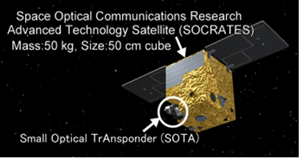Jul 11 2017
Highlights
- Quantum communication successfully demonstrated between a satellite and a ground station
- A major step toward the development of future satellite constellations using small satellites
- It enables the adoption of this technology in a global truly-secure communication network
The lightest and smallest quantum-communication transmitter (SOTA) in the world has been developed onboard the microsatellite SOCRATES by NICT.
NICT succeeded in demonstrating the very first quantum-communication experiment from space, getting information from the satellite in a single-photon regime in an optical ground station based out of Koganei city. The size of SOTA is 17.8 cm length, 11.4 cm width and 26.8 cm height and it weighs 6 kg. A laser signal is transmitted to be ground by SOTA at a rate of 10 million bits per second from an altitude of 600 km at a speed of 7 km/s. The NICT team succeeded in correctly identifying the communication signal from SOTA moving at this rapid speed. This is considered to be a vital step in constructing a global long-haul and truly-secure satellite communication network.
 Image of SOTA onboard SOCRATES. Credit: NICT
Image of SOTA onboard SOCRATES. Credit: NICT
This research led NICT to demonstrate the possibility of implementing satellite quantum communication with small cost-effective satellites. This indeed allows this key technology to be used by several companies and research institutions. It is considered to be an achievement that opens a new phase in the production of future global communication networks, which indeed is a major boost to the space industry.
The renowned peer-reviewed journal "Nature Photonics" agreed to publish the outcomes of this research (August 2017 physical issue, electronic version accessible from July 11th, 2017).
The research was partially supported by the ImPACT (Impulsing PAradigm Change through disruptive Technologies) Program of the Cabinet Office of Japan.
Background
During this century, the technologies that needed to launch small satellites in a cost-effective manner experienced great advancements and major efforts are currently being executed in order to develop satellite constellations to attain a global communication network covering the whole Earth. There is however the need for a technology capable of transmitting huge amounts of information from the space to the ground within a short time span, and the existing RF bands are already congested, thus putting forth a blockage of communication capacity. Satellite optical communication, via the usage of lasers, is able to possess a readily-available frequency band and can also transmit with greater power efficiency and with lighter and smaller terminals. It is thus expected to be a significant technology that will help support the next generation of satellite communication networks. Quantum communication, especially Quantum Key Distribution (QKD), is another vital technology that ensures providing the information security of the next global communication networks. Existing QKD links are restricted to several hundreds of km, thus, in this venture, it is indeed a basic step to implement satellite-to-ground QKD. QKD research is actively carried out in the United States, Canada, Europe, China and Japan. A large (635 kg) quantum-communication satellite was launched by the University of Science and Technology of China in August 2016, and a quantum-entanglement experiment with two ground stations was also performed.
Achieved results
SOTA is considered to be the world’s lightest and smallest quantum-communication transmitter embarked on the microsatellite SOCRATES. Two polarization states, encoding ‘0’s and ‘1’s, were transmitted by SOTA to the ground at a rate of 10 million bits per second. The NICT optical ground station in Tokyo's Koganei city received the signals from SOTA using a 1 m telescope in order to gather the transmitted photons and then guide them to the quantum receiver for decoding the information using a QKD protocol.
The signal that breached the 1 m telescope is very weak, with an average of 0.1 photons for each received pulse. The technology was developed by NICT in order to carry out the time synchronization and polarization reference frame identical between the satellite and the ground station directly from the QKD signals. The NICT developed quantum receiver has the potential to detect such a weak signal with low noise. The NICT team demonstrated the quantum communication, the very first in the whole world, from a 50 kg microsatellite. This will help in developing future secure links from space by employing quantum cryptography to totally prevent the leakage of information.
Future prospects
This newly developed technology demonstrated the possibility of implementing satellite quantum communication by using cost-effective lightweight microsatellites. Several research institutes and companies, interested in this technology, are thus expected to increase the practical application of quantum communication from space. Since it has been established that long-distance communication can be achieved with very-low electric power, this will indeed make room for speeding up deep-space optical communication with exploration spacecraft.
Going forward, the NICT team plans to further increase the transmission speed and enhance the precision of the tracking technology in order to maximize the secure key delivery from space to ground by employing quantum cryptography enabling a global communication network that is truly secure and whose confidentiality is being presently threatened by the futuristic development of quantum computers.